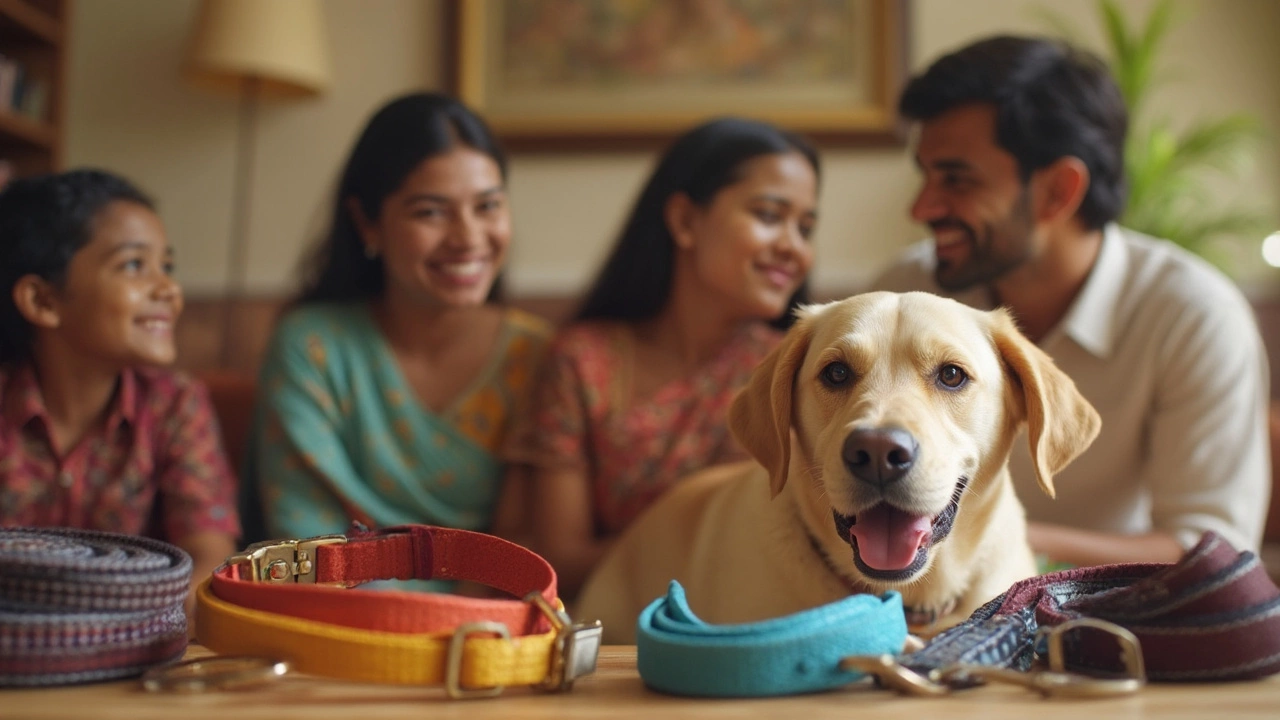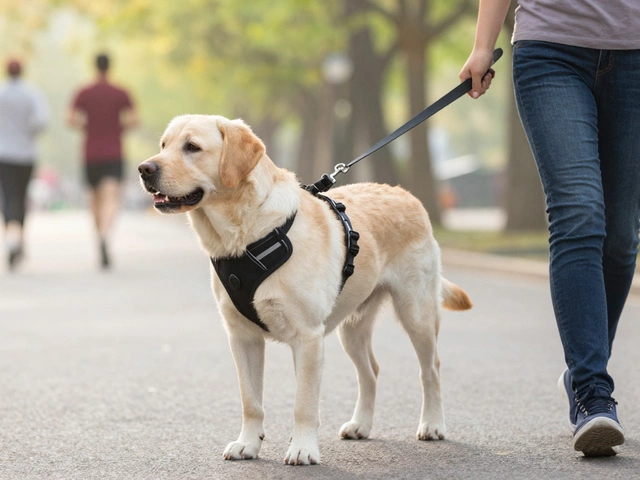
If you've ever worried about your dog's collar getting snagged on a fence or their ID tag catching something while they're out and about, you're definitely not alone. Breakaway collars sound fancy, but here's the big idea: the clasp is designed to pop open if enough pressure gets put on the collar. It's basically a seatbelt for your dog's neck.
A lot of folks picture worst-case scenarios—dogs getting stuck while playing rough at the park or panicking when their collar's caught in the crate. These moments can go from scary to tragic in a heartbeat, which is why breakaway collars have been popping up in more pet stores lately. They’re not just made for cats—dogs get into just as much mischief (sometimes more, if you ask anyone who's owned a Labrador).
The real question isn’t "should every dog wear a breakaway collar?" but rather, "when does it make sense for your dog?" Collars are more than accessories. They're about control, safety, and, let’s be honest, making sure our dogs make it back to us if they pull off another Houdini act. The right collar can be a lifesaver—literally. So what should you actually consider when you pick out a collar for your dog? Buckle up—time to dig into the details that could save your best friend's neck, both figuratively and literally.
- What Is a Breakaway Collar and How Does It Work?
- Everyday Risks: Why Collar Safety Matters
- Breakaway Collars vs Traditional Collars
- When Should Dogs Wear Breakaway Collars?
- Potential Downsides and Safety Concerns
- How to Choose the Right Collar for Your Dog
What Is a Breakaway Collar and How Does It Work?
A breakaway collar is pretty much exactly what it sounds like—a collar for your dog that’s built to come apart under pressure. The goal is simple: if something tugs hard enough on the collar, like a fence picket or another dog's tooth during play, the collar snaps open and releases your dog. This can help prevent choking, neck injuries, or worse. It’s a small tweak on a regular dog collar, but it’s a big deal safety-wise.
How does the mechanism work? Instead of the usual buckle or clasp, breakaway collars use a special fastener that’s spring-loaded or designed with plastic prongs. You pop it together like any other collar, but if there’s sudden, strong pulling—like your dog’s collar getting stuck on a branch—the clasp comes apart before your dog gets hurt. The pressure required to break away is usually just enough so normal walking or gentle tugs won’t set it off, but something dangerous will.
Here's what sets them apart from standard collars:
- Breakaway collars protect against strangulation accidents. Traditional collars just won’t come off if they snag—bad news in a crisis.
- Some brands let you temporarily lock the clasp for leash walks, then unlock it for free play or off-leash time. Not all are built that way, so definitely check the packaging before you buy.
- Most dog collars are made for ID tags only, but with a breakaway version, you’re also dodging a real risk, especially for active or curious dogs.
One study out of the University of Pennsylvania's vet school showed collar accidents led to serious injury or death in about 26% of reported cases. That’s a stat most dog owners never even think about. And it makes sense—if you’ve got a young puppy, a small dog, or one who loves wiggling into tight spaces, the extra safety of a breakaway collar is worth considering.
Everyday Risks: Why Collar Safety Matters
Dog collars seem harmless, but there are plenty of everyday hazards that you might not think about until they happen. If you’re a dog safety nut (and, honestly, who isn’t after watching a pup get stuck?), you’ll want to know what you’re up against. Dogs love to explore, wrestle, and get into tight spaces. All that curiosity and energy? It comes with risks.
Here’s the thing: even simple stuff like roughhousing with another dog or rooting around under the porch can turn a collar into a trap. The most common risks with traditional collars include:
- Snagging on furniture, crates, fences, or low branches—happens in a heartbeat, especially if your dog likes to squeeze into tight spaces.
- Teeth and jaw injuries—when dogs play, they sometimes grab each other's collars. It takes just seconds for a jaw or tooth to get stuck.
- Choking accidents—this is the big one. If a collar gets caught and the dog panics, they can choke or suffer neck injuries fast.
Think this sounds rare? A 2022 survey among U.S. veterinarians found that about 1 in 10 reported seeing dogs with injuries from collar-related accidents every year. That doesn’t count the scary close calls owners handle at home.
Crates are a sneakier source of trouble. Tags and collars can wedge in gaps or bars, even when you think you’ve cleared the space. If you use baby gates or let your dog roam a yard with fencing, the risk jumps higher. Dogs love to poke their heads through things—sometimes that collar brings a nasty surprise.
You might also hear from doggy daycare or boarding staff about their "no-collars-inside" rule. They aren't being fussy. Most group facilities ban collars because they’ve dealt with enough emergency calls from playtime gone wrong. It’s just not worth the risk when a strong, playful tug can turn a dog collar into a dangerous noose.
All of this adds up to a simple fact: everyday life is full of little dangers you barely notice, until they go sideways. That’s why breakaway collars get so much attention. They’re not about wrapping your pup in bubble wrap, but making sure the gear they wear every day isn’t what puts them at risk.
Breakaway Collars vs Traditional Collars
Let’s get right into what actually sets a breakaway collar apart from your regular, run-of-the-mill dog collar. Traditional collars have a buckle, snap, or sometimes a martingale-style loop. Once fastened, they stay put unless you unclip or loosen them yourself. They’re what most people think of as a “dog collar.”
Breakaway collars come with a safety catch that pops open under pressure—like if your dog’s collar gets snagged on a branch or fence. The whole idea is to prevent choking or neck injuries if your dog gets stuck somewhere while exploring or playing. They snap open by design, then you just reattach it with a click.
Here’s a quick breakdown of common features:
- Traditional collars: Great for attaching a leash, ID tags, and control during walks. But they don’t release if the dog is trapped or panicking.
- Breakaway collars: Engineered for safety if your dog gets hung up on something. They’re less about control and more about accident prevention. Some even come with two D-rings, so you can attach both leash and ID tag—but the breakaway feature only kicks in with pulling from a snag, not regular walking.
One thing folks don’t always realize: regular collars are linked to accidents, especially for dogs left unsupervised with their collars on. According to data collected by the ASPCA, collar strangulation is a known (though underreported) risk—especially if you have two or more dogs that play rough together.
| Collar Type | Best For | Main Risk |
|---|---|---|
| Traditional | Walks, control, ID tags | Snagging/strangulation if caught |
| Breakaway | Free play, unsupervised time, safety | May detach too easily, lost tags |
If your biggest worry is your dog slipping out of their collar on a busy street, a traditional collar might feel safer for walks. But if they’re a climber, backyard explorer, or love to wrestle with other pups, that’s where breakaway collars give a real layer of protection.

When Should Dogs Wear Breakaway Collars?
This is where things get interesting—because breakaway collars aren't something every dog needs twenty-four seven. Their real magic kicks in at certain times and places. So, when do these collars actually make sense?
If your dog spends time in the yard unsupervised, a dog collar that releases under strain can be a lifesaver. Dogs love to stick their heads through fences or get tangled in bushes, and sadly, accidents do happen. The American Veterinary Medical Association pointed out,
"Collars are a top cause of accidental injury for outdoor pets, and breakaway mechanisms can reduce strangulation risks considerably."
Dogs that play rough at the dog park are another big group that could use a breakaway collar. Fast chases and wrestling matches often turn into collar-grabbing chaos. A breakaway could pop open before things get dangerous.
Here are specific situations where a breakaway collar is a smart move:
- Your dog is left alone with their collar on, such as in the yard or home (not recommended, but it happens).
- You have a multi-dog household and your pups love to roughhouse.
- Your dog likes to sneak under fences, climb, or gets into tight spaces.
- They wear ID tags but aren't always supervised.
Take a look at this quick rundown of common risks versus breakaway collar benefits:
| Situation | Risk | Breakaway Collar Solution |
|---|---|---|
| Rough play with other dogs | Choking/strangulation if collar gets grabbed | Collar pops open under pressure |
| Fenced yards, bushy areas | Collar snagged on objects | Breakaway release prevents injury |
| Indoors, when unsupervised | Collar caught on crate or furniture | Reduces risk of accidents |
One thing to remember: breakaway collars aren't for activities where you need control, like on-leash walking. They're meant for safety at home, during unsupervised play, or in multi-dog situations. Get in the habit of swapping out to a regular collar or harness for walks—the extra step is worth it.
Potential Downsides and Safety Concerns
Breakaway collars might sound like a no-brainer at first, but there are a few catches you should know about. First off, because these collars are made to pop open under pressure, some dog owners worry about losing control during walks. If your dog collar unlatches suddenly near traffic or in the middle of a stressful situation, things can go south quickly. Most breakaway models can be clipped to a regular leash for walks, but always double-check—some brands aren't designed for use with a leash at all.
There’s another thing: if your dog figures out how to trigger the breakaway clasp on purpose (and some clever pups absolutely can), you may find yourself hunting for a collar in the backyard more often than you like. Replacing lost dog collars again and again adds up fast—it’s a small cost, but it gets annoying.
Here’s a useful table comparing traditional and breakaway collar drawbacks:
| Collar Type | Main Issue | When It Matters |
|---|---|---|
| Traditional Collar | Risk of snagging/choking | When unsupervised or roughhousing |
| Breakaway Collar | Can pop open (lost ID tags, control issues) | During leash-walks or if dog escapes yard |
Some daycare centers and groomers don't allow breakaway collars because they're worried about dogs slipping out. And if your dog tends to pull like they're in a sled race, even the best breakaway option can snap open when you least expect it. For dogs with a "great escape" habit or those that need extra control, you might want to look for a collar with a double-lock feature or a backup attachment point for the leash.
One last thing—don’t forget the simple stuff: always check the collar for wear and tear. Even a breakaway mechanism can fail if it’s full of fur, dirt, and mystery gunk from the dog park. Regular cleaning and a quick test snap every month can make a big difference in real safety.
How to Choose the Right Collar for Your Dog
Picking out the right collar can feel overwhelming—there are dozens of choices every time you check online or step into a pet store. But if you break it down, it comes down to knowing your dog's habits, needs, and your own comfort with the collar’s safety features. Here are the main things to consider when trying to choose between traditional and breakaway collars (or any other style):
- Safety First: For dogs who love to slip through fences, play rough with other dogs, or get into tight places, breakaway collars can really lower the risk of choking or serious neck injuries. If your yard is escape-proof and your dog is a total couch potato, a standard collar might do just fine.
- Everyday Wear vs. Going Out: Breakaway collars are great around the house and yard, but they’re not made for walks—a strong tug on the leash, and they’ll snap open. For walks, use a sturdy harness or a classic collar just for the trip.
- Sizing: Dogs come in all shapes and sizes. Make sure whatever collar you get fits snugly but not tightly. The rule of thumb: you should be able to slip two fingers between the collar and your dog’s neck.
- Material: Nylon, leather, and even soft silicone all have pros and cons. Nylon is lightweight and dries quickly, while leather is durable but needs more care. Don't pick something that will cause irritation, especially if your pooch has sensitive skin.
- ID Tags and Tech: No matter which dog collar you pick, make room for an ID tag or microchip info. Even the best collar can't help if there’s no way for someone to call you when they find your dog.
Let’s look at some simple data when folks are shopping for collars:
| Collar Type | Best For | Not Recommended For |
|---|---|---|
| Breakaway | At-home safety, fence-jumpers, playful dogs | Walks, tie-outs, pullers |
| Traditional Buckle | Walks, ID tags | Dogs left unsupervised outside, heavy players |
| Martingale | Greyhounds, dogs that slip out of regular collars | Unsupervised use |
If you have more than one dog, or your home has both cats and dogs (I’ve lived this life!), be extra cautious—collars can get tangled when animals play. And if your dog is a notorious chewer, regularly inspect their collar for signs of wear. Don’t forget to check the fit every few months—a collar that fit last summer could be too tight after a winter growth spurt.
Bottom line? There’s no single collar that works for every situation. Think about your dog's habits. Weigh the risks. Choose safety when in doubt—your dog counts on you to keep them out of avoidable trouble.





